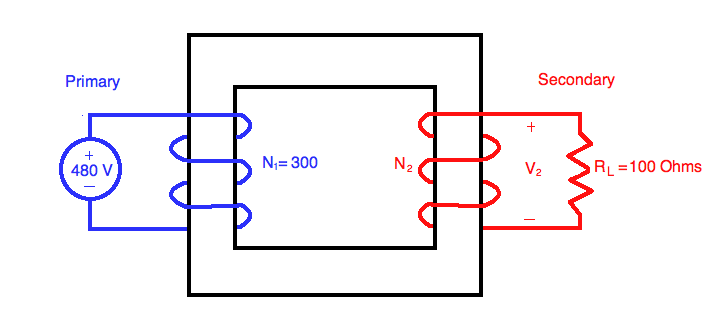Transformer example problem: Difference between revisions
| Line 1: | Line 1: | ||
===Problem:=== |
===Problem:=== |
||
An ideal transformer with a 300 turn primary connected to a 480 V, 60 Hz supply line needs to output 120 V from the secondary. If a 100 Ω resistor is connected across the secondary, determine: A) How many turns the secondary must have to output the desired voltage. B) The current through the resistor, C)The current drawn through the primary. D) The maximum flux in the core of the transformer |
An ideal transformer with a 300 turn primary connected to a 480 V, 60 Hz supply line needs to output 120 V from the secondary. If a 100 Ω resistor is connected across the secondary, determine: A) How many turns the secondary must have to output the desired voltage. B) The current through the resistor, C)The current drawn through the primary. D) The maximum flux in the core of the transformer |
||
[[Image:Transformer_EMEC.png]] |
|||
===Solution:=== |
===Solution:=== |
||
Revision as of 00:26, 18 January 2010
Problem:
An ideal transformer with a 300 turn primary connected to a 480 V, 60 Hz supply line needs to output 120 V from the secondary. If a 100 Ω resistor is connected across the secondary, determine: A) How many turns the secondary must have to output the desired voltage. B) The current through the resistor, C)The current drawn through the primary. D) The maximum flux in the core of the transformer
Solution:
Part A:
The ratio of primary voltage to secondary voltage is directly proportional to the ratio of number of turns on the primary to number of turns on the secondary:
Where Voltage across primary,
Voltage across secondary,
Number of turns in primary,
Number of turns in secondary
To solve for the number of turns required for the secondary, the equation is rearranged solving for :
Part B:
The voltage across the secondary is given in the problem statement as 120 volts. Using ohms law, , we can solve for the current in the loop ( ).
Where Current through secondary,
Voltage across secondary,
Load Resistor ( 100 Ω)
Part C:
The ratio of primary current to secondary current is inversely proportional to the ratio of number of turns on the primary to number of turns on the secondary:
Where Current in primary,
Current in secondary,
Number of turns in primary,
Number of turns in secondary
Rearranging to solve for :
Part D:
The induced emf of the secondary can be calculated by: <ref>Guru and Huseyin, Electric Machinery and Transformers, 3rd ed. (New York: Oxford University Press, 2001), 209.</ref> Solving for , we can calculate the maximum flux in the core:
Where max flux in core, Voltage across secondary, Frequency of line, Number of turns in secondary
References:
<references/>
























